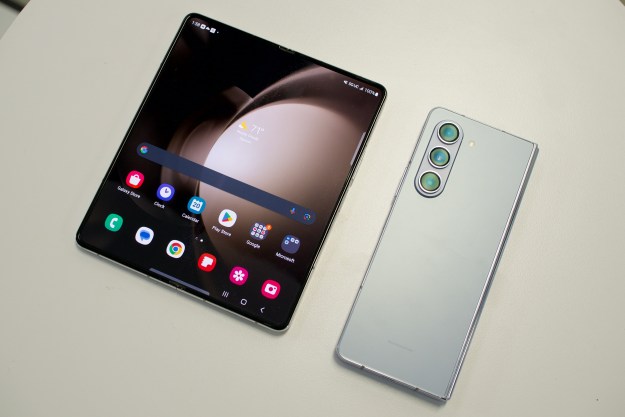The Asus ZenFone Zoom 2 was a stunner of a midrange smartphone. It featured 3x optical zoom, great low-light camera performance, and an excellent battery life to boot. The latest addition to the Taipei, Taiwan-based company’s Zoom series continues in the original’s tradition. At the Consumer Electronics Show in Las Vegas in January, Asus took the wraps off the ZenFone 3 Zoom, a smartphone with a top-of-the-line camera, massive battery, and shooting modes out the wazoo. Unfortunately, it’s now being delayed until the second quarter of 2017.
Impressive cameras
The ZenFone 3 Zoom, true to its namesake, features a dual-camera system capable of high degrees of optical zoom. It comprises a 12-megapixel camera with a f/1.7 aperture, a 25mm wide-angle lens, and a secondary 12-megapixel, 56mm camera that handles macro shots as close as 3.94 inches. The rig’s capable of up to 2.3x optical zoom, Asus says, and offers a new shooting mode called Portrait that is similar to the iPhone 7s’s “bokeh” mode: backgrounds of photos are softly blurred as subjects are brought to the fore.
A manual shooting mode exposes most of ZenFone’s toggles to intrepid photographers. Settings like white balance, exposure values, focus, ISO, and shutter speed are adjustable. And a Full Manual mode allows the user to override the phone’s automatic camera selection and chose from either the 25mm, f/1.7 lens of the main camera or the 56mm lens of the zoom camera.
Autofocus is drastically improved on the ZenFone 3 Zoom too, thanks to a new solution that Asus calls TriTech+. Two phase-detection sensors on the ZenFone 3 Zoom’s camera pixels analyze the variations in light rays hitting the sensors and, in tandem with the other 12 million pixels on the ZenFone 3 Zoom’s sensor, focus continuously on subjects. The trifecta’s final bit, a second-generation laser focus technology with three times the range of comparable implementations on the market, helps the ZenFone 3 Zoom achieve a focus time of just 0.03 seconds.
The ZenFone 3 Zoom’s other photographic innovation is what Asus calls the SuperPixel, a technology that increases light sensitivity “dramatically” compared to the average smartphone. A 1.4-micron pixel size augments the camera’s dim-environment performance and reduces graininess, and a Sony IMX362 image sensor lets in more light.
The ZenFone 3 Zoom’s other camera touches are no less impressive. Four-axis optical image stabilization and three-axis electronic image stabilization minimizes shake and blur. A color-correction sensor automatically adjusts the photo pallets to look “natural” and “accurate.” And the phones’s front camera, not to be outdone by the dual-camera tech, sports a 13-megapixel lens and “screenflash,” a mode that uses the ZenFone’s display as a flash.
Finally, the ZenFone 3 Zoom’s shooters feature three new modes: Super Resolution, 3MP Enhanced Low Light, and HDR. Super Resolution stitches four 12-megapixel photos to create a single image. Low Light mode combines four adjacent pixels to work as a single pixel that shoots better in low-light conditions and prevents blurring. And HDR mode layers an overexposed image atop an underexposed image to enhance details.
Hardware and Specs
The ZenFone 3 Zoom’s innovations don’t end with high-tech cameras. The handset boasts a sandblasted aluminum-alloy body that measures 0.31-inches thin and 0.37 lbs in weight, and a Qualcomm Snapdragon 625 processor and 5.5-inch Full HD (1920 x 1080 pixels) display shielded by Corning’s Gorilla Glass 5. It also features 3GB of RAM and 32GB of storage, and runs Android 7.0 Nougat.
If there’s an undisputed hardware highlight, though, it’s the ZenFone 3 Zoom’s battery. The 5,000mAh cell has “one of the highest capacities of any smartphone,” Asus contends, and the largest in a
Pricing and Availability
After an initial delay (the handset was supposed to be made available in February 2017), the ZenFone 3 Zoom has been made available. It starts at $329 (about $80 less than the initial projected price of $400), and you can grab the handset from major U.S. retailers including Best Buy and Amazon, and of course, the Asus website.
Updated on 02-24-2017 by Lulu Chang: Added news of ZenFone 3 Zoom’s release date and price.
Editors' Recommendations
- The Zenfone 9 looks like the small 2022 flagship you’ve been waiting for
- Realme’s high-spec X3 SuperZoom phone is an incredible value for the money
- The Asus Zenfone 6 goes its own way with flip-over camera and 5,000mAh battery

